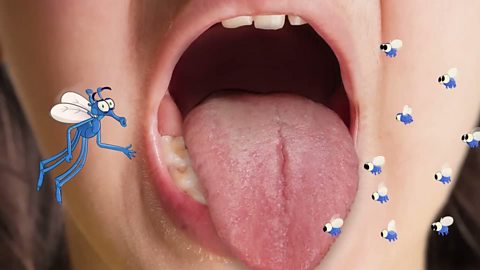How does the human ear work?
Video - How do humans hear?
In this video, learn about the human ear and how it works.
Find out how the ear and brain work together to let people hear.
Welcome, class, to the fascinating subject of today’s lesson: the human ear.
This big thing on the side of the head is called the outer ear.
It’s shaped a bit like a funnel, which helps it collect sound waves and send them down into the middle ear.
Now then, who’s small enough to get down there?
Sammy, be a sport and buzz down into the ear.
You should now be deep in the ear canal. As you can see, there’s lots of gloopy ear wax down there.
Ear wax traps any dirt that might get inside the ear and contains chemicals to fight off infections.
Carry on down Sammy!
All the way at the back of the ear canal is the ear drum. This is actually a very sensitive piece of tightly stretched skin. When sound waves come into contact with it, it vibrates.
The louder the sound, the bigger the vibration!
The vibrations move 3 tiny bones on the other side of the drum and make their way into a small spiral tube, where special hearing receptors turn them into signals.
The signals get sent up through a nerve to the brain, where the brain makes sense of them as sounds.
So, as you can see, there’s a lot more to the human ear than meets the eye.
Mind the ear drum on your way out Sammy!
Key words about the human ear and hearing
Outer ear - Part of the ear you can see. Shaped like a funnel to collect sound waves and send them to the inner ear. Also called the pinna
Ear canal - Tube that runs from the outer ear to the inner ear. Lined with cells that produce ear wax
Ear wax - Protects the ear by trapping dirt and fighting infections
Ear drum - Thin layer of tightly stretched skin. It vibrates when sound waves hit it
Hammer or Malleus - One of the three tiny bones in the ear. It moves when the ear drum vibrates
Anvil or Incus - The second tiny bone in the ear. The anvil is moved by the hammer
Stirrup or Stapes - The third tiny bone in the ear. It is moved by the anvil
Cochlea - Spiral tube. When the stirrup moves, fluid inside the cochlea moves. Hearing receptors turn the movement into signals
Auditory nerve - Carries messages from the cochlea to the brain. The brain makes sense of these signals as sounds
A labelled ear
Click on the labelled parts of the human ear to learn about what they do.
Quiz
More on Senses
Find out more by working through a topic
- count3 of 6

- count4 of 6

- count5 of 6

- count6 of 6
